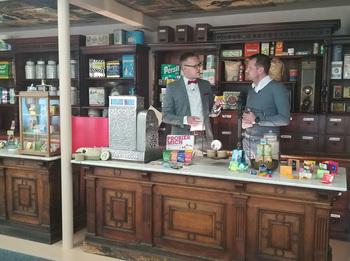
The CG Lounge Talk in the historic 'Bonbon Museum'
 At JUNG's Bonbon Museum Arne Bender and Steven Baumgärtner talk about the history of JUNG as well as the history of sweets, together with more than 40 new products. In an exciting setting we learn, among other things, what the original use of the large tin of sweets was.
At JUNG's Bonbon Museum Arne Bender and Steven Baumgärtner talk about the history of JUNG as well as the history of sweets, together with more than 40 new products. In an exciting setting we learn, among other things, what the original use of the large tin of sweets was.In Vaihingen an der Enz there are extraordinary things to see and experience: here visitors will find the only sweets museum in Germany. In JUNG's Gummi-Bären-Land (factory outlet), the yummy history of sweets is presented in an entertaining, interesting permanent exhibition. Anyone who has ever wanted to know where sweets actually come from, who ate them first, how they were produced and sold in the past, why they help against coughs and since when they have been given away in promotional wrappings has come to the right place at the Bonbon Museum. Here sweets, sweet tins, production machinery and old advertising materials are presented in a humorous cultural-historical exhibition covering 300 square metres.
The first attempts to discover the tasty secret of making sweets were made by JUNG as early as 1828. What started out as a small confectioner's developed over time into a company with a wide and innovative range of products. Former managing director Walter Kühlbrey took the first steps towards the classic promotional sweets. With his idea of offering sweets in individually printed wrapping paper he set the tradition-rich company on the right course. However, the company's product range has gone well beyond promotional sweets. Today sweets, snacks and the like are an integral part of the promotional world. In addition to extensive seasonal Christmas and Easter articles, customers can also find protein bars, apple cubes and dextrose as well as classic products such as herbal sweets, fruit gums and pretzels. Sustainable, vegan and sugar-free articles complete the diverse assortment, so that every customer wish can be fulfilled.
New in the snacks area are various delicious nut varieties in a cool tin. There are also cheese chips and bread chips from Germany, and pizza snacks from Italy. Of course, the popular Pretzel Balls from Roland in the eye-catching pyramid packaging are also available. The apple cubes are a healthy but above all crunchy and fruity addition. These highly popular dried apple pieces are now available in new cool packaging. Steven Baumgärtner tasted many different samples and enjoyed one taste experience after the other. "Quality is in the taste, and it's very important to us that people should be able to experience this in our products. We don't use cheap raw materials and always make sure that we have the best". Accordingly there are many branded products such as Powerbar, Trolli, Skittles, Mars, Bahlsen, Lindt and many more in the company's product range.
The Slim Box Mini contains what are probably the smallest sweets in the world. It offers enough space for the advertising message and for the sweets, but is still small enough to fit in your trouser pocket. Thanks to its click closure, it can be opened and closed quickly. It is now also possible to fill the small box with Skittles or M&M's for when you are out and about. A Powerbar in a stylish promotional slipcase is the ideal solution for the next company run, for sports enthusiasts and for nutrition junkies. Handy, small and tasty, it provides the right energy supply before and after a workout.
The super cool Advent calendar in truck form is also guaranteed to attract attention. The generous promotional space can be printed individually on all sides and there are tasty Ritter SPORT chocolate bars hidden behind the doors. It consists of fully recyclable materials and 100 % carbon-neutral production.
The nostalgic mini sweet jar conveys a crystal-clear advertising message. It can be filled with sweets of various flavours as required. As the icing on the cake, the closure can be individualised with doming.
JUNG has two beehives of its own on the roof and produces honey sweets from them. In addition, the company supports the "nearBees" project. This stands for environmental protection and sustainability, as well as local and responsible consumption. The nearBees project radically simplifies the marketing of honey for beekeepers and also provides convenient access to local honey.
In the authentic replica of the 1893 shop where sweets and chemicals used to be sold, Arne Bender solved the mystery of what the large sweet tin was originally used for. It was welded shut and attached to both sides of those learning to swim in order to provide sufficient buoyancy and prevent them from sinking.
New in the area of sustainability is foil that can be composted in the garden and is filled with Trolli fruit gums with fruit pieces or their vegan variant. For Arne Bender the most ecologically sensible version is the perforated card filled with sweets. The product is eaten and there is little waste.




